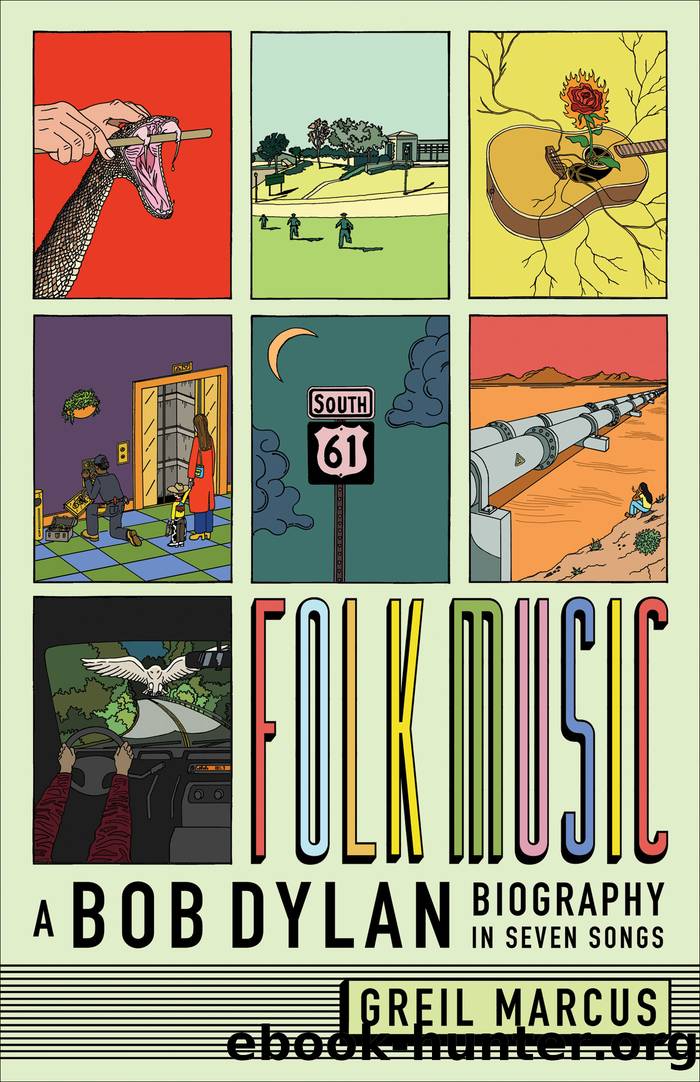Folk Music by Greil Marcus

Author:Greil Marcus
Language: eng
Format: epub
Publisher: Yale University Press
Published: 2022-11-15T00:00:00+00:00
THE TIMES THEY ARE A-CHANGINâ
* * *
1964
âI sang a lot of âcome all youâ songs,â Bob Dylan said in 2015 in his MusiCares address, telling the tale of his whole musical life. âThereâs plenty of them. Thereâs way too many to be counted. âCome along boys and listen to my tale / Tell you of my troubles on the old Chisholm Trail.â Or, âCome all ye good people, listen while I tell / The fate of Floyd Collins, a lad we all know well.â â
âCome all ye fair and tender ladies / Take warning how you court your men / Theyâre like a star on a summer morning / They first appear and then theyâre gone again.â And then thereâs this one, âGather âround, people / A story I will tell / âBout Pretty Boy Floyd, the outlaw / Oklahoma knew him well.â
If you sung all these âcome all yeâ songs all the time like I did, youâd be writing, âCome gather âround people where ever you roam, admit that the waters around you have grown / Accept that soon youâll be drenched to the bone / If your time to you is worth saving / And you better start swimming or youâll sink like a stone / The times they are a-changinâ.â
Youâd have written that too. Thereâs nothing secret about it. You just do it subliminally and unconsciously, because thatâs all enough, and thatâs all you know. That was all that was dear to me.
âCome senators, congressmen, please heed the call / Donât stand in the doorway, donât block up the hall / For he who gets hurt will be he who has stalled / The battle outside raginâ / Will soon shake your windows and rattle your walls / For the times they are a-changinâ ââas with âBlowinâ in the Windâ the year before, in 1964 it seemed obvious. Obvious who was who, what was up and what was down, who was trying to make history and who was trying to stop it. The song was so programmatic it could have been written by a committee. The come-all-ye tradition tipped right over into the finger-pointing tradition, the right side calling out the wrong side in a big, righteous march to shout down the walls of Jericho. âThe pep rally, the Sousa march, the football cheerââit could have been written as an illustration for Little Sandy Reviewâs âP-FOR-PROTEST.â âIt was ironic that Bob Dylanâs picture should have been placed next to Jerry Lewisâs on the recent ESQUIRE cover awarding the dubious achievements for 1964,â Paul Nelson and Jon Pankake wrote in the last number of Little Sandy Review, in early 1965.
Those sad, sensitive eyes are a kind of counterpart of Lewisâs grimace. Both of them have serious strivings beyond their actual abilities; both are victims of the show biz syndrome; both are clownish entertainers to a popular audience incapable of understanding anything but their very broadest effects; both are idolized by a cult of pseudo-intellectuals who rationalize their shortcomings
Download
This site does not store any files on its server. We only index and link to content provided by other sites. Please contact the content providers to delete copyright contents if any and email us, we'll remove relevant links or contents immediately.
The Goal (Off-Campus #4) by Elle Kennedy(13379)
Kathy Andrews Collection by Kathy Andrews(11688)
Diary of a Player by Brad Paisley(7422)
What Does This Button Do? by Bruce Dickinson(6107)
Assassin’s Fate by Robin Hobb(6063)
Big Little Lies by Liane Moriarty(5660)
Altered Sensations by David Pantalony(5013)
Pale Blue Dot by Carl Sagan(4867)
Sticky Fingers by Joe Hagan(4071)
The Death of the Heart by Elizabeth Bowen(3492)
The Heroin Diaries by Nikki Sixx(3460)
Beneath These Shadows by Meghan March(3233)
Confessions of a Video Vixen by Karrine Steffans(3212)
How Music Works by David Byrne(3089)
The Help by Kathryn Stockett(3051)
Jam by Jam (epub)(2994)
Harry Potter 4 - Harry Potter and The Goblet of Fire by J.K.Rowling(2949)
Strange Fascination: David Bowie: The Definitive Story by David Buckley(2767)
Petty: The Biography by Warren Zanes(2646)
